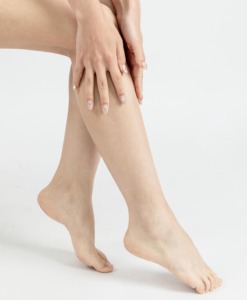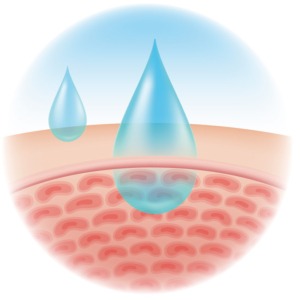We carried out a study to evaluate the skin penetration of natural oils and their potential application as skin penetration enhancers for dihydroquercetin (DHQ) delivery. We found that applying olive oil, avocado oil, soybean oil, sea buckthorn oil, coconut oil, and soybean oils increases the content of fatty acids (FAs) in the ex vivo skin layers. Moreover, soybean oil and olive oil are effective skin penetration enhancers for DHQ delivery.
Natural oils are complex lipid mixtures containing various ratios of saturated and unsaturated FAs. There is no direct data proving the interaction between FAs mixtures and the human skin barrier; therefore, knowledge about individual FAs can be used to predict their skin penetration enhancement effects.
Lipid protein partitioning theory explains the interaction between individual FAs and the skin barrier. According to this theory, FAs containing a C18 chain and at least one double bond have the potential to form a “kink” structure and can disrupt the ordered skin lipids.
Oleic acid was used as a model FA to prove the theory since it is a C18 FA and it contains a cis double bond at the C9 position. After evaluating FAs structure differences, it resulted in the perturbation of skin lipids and changes in penetration enhancement, suggesting that C18 FAs with more than one double bond should increase the fluidity of skin lipids even more. This indicates that C18 linoleic acid, containing two unsaturated double bonds, should disturb the skin lipids more than oleic acid.
Alternatively, C16 palmitoleic acid should be less effective in penetration enhancement. This relation was confirmed in the study of diclofenac penetration enhancement by various FAs. Our recent study demonstrated that the application of linoleic acid on the skin induces the redistribution of endogenous FAs. It suggests that it can disorder the skin lipids in both skin layers since no such effect was determined for palmitoleic, oleic, stearic, and palmitic acids.
However, saturated palmitic and stearic FAs have limited abilities to enhance skin penetration due to their straight-chain structures and high melting points.
The above-mentioned FAs are present in natural oils, which were tested in the current study. Time of flight secondary mass spectrometry (TOF-SIMS) imaging analysis demonstrated significant FAs distribution changes in the skin subjected to the application of natural oils. Based on the effects of individual FAs, natural oils containing high amounts of oleic and linoleic FAs were expected to demonstrate higher disordering of the skin lipids and skin penetration enhancement of DHQ.
Soybean, olive, avocado, sea-buckthorn pulp, raspberry seed oils contain high amounts and different concentrations of unsaturated C16–C18 FAs. Significant skin penetration enhancement of DHQ was demonstrated by soybean and olive oils.
Soybean oil increased the partitioning of DHQ into both skin layers, while the effect of olive oil was only found in the dermis. These effects can be related to the highest concentration of linoleic acid determined in soybean oil and oleic acid in olive oil. TOF-SIMS analysis of soybean-treated samples demonstrated the highest increase of linoleic acid in the epidermis. The oleic acid content in olive oil treated samples was not as high as in samples treated with raspberry seed oil treated. Also, a significant increase of linoleic acid content was determined in both skin layers of the samples treated with olive oil.
However, raspberry seed oil contains a similar concentration of linoleic acid as soybean oil, and avocado oil has a very close FAs composition to olive oil but did not show skin penetration enhancement of DHQ. Moreover, raspberry seed oil and sea-buckthorn pulp oil demonstrated the highest increase of total FAs content in the skin.
Alternatively, coconut oil demonstrated minor FAs distribution changes and reduced skin penetration of DHQ. Coconut oil is mainly composed of straight-chain unsaturated FAs, and the lowest skin penetration is expected due to their higher melting points. Skin penetration experiments for natural oils were carried out for 6 hours, while DHQ penetration experiment in the presence of natural oils was carried out for 24 hours. The different duration of experiments was employed to evaluate the early effects of FAs penetration from natural oils and determine the penetration of DHQ into the skin layers. Low penetration of DHQ has been expected. Therefore, prolonged experiments allowed the detection of DHQ in both skin layers above the quantification limit. FAs from natural oils penetrate into the skin, but there is no direct relation between the concentration of particular FA in natural oil, its increase in the skin layers, and skin penetration enhancement for a target molecule.
Predominant components in natural oils are triglycerides, while FAs are minor constituents along with mono and diglycerides, phosphatides, sterols, fatty alcohols, fat-soluble vitamins, and other substances. FAs from natural oils interact with the skin as a mixture of skin penetration enhancers and are also affected by the presence of other components. This increases the complexity of natural oil interaction with the skin barrier and becomes challenging to find a correlation between the composition and penetration enhancement using currently available methodological approaches.
Moreover, the quality and FA composition of natural oils can be affected by various factors, such as origin, quality of raw materials, preparation methods, or storage conditions. Therefore, natural oils used in the formulation of topically applied products should be tested for their FAs content and standardized or tested for their potential interaction with the skin.
Standardization of natural oils and evaluation of acceptable variability in FAs composition would provide more possibilities for the safe application of natural oils in the formulation of topically applied products.
Overall, this study demonstrates that natural oils should not be treated as passive components. TOF-SIMS bioimaging analysis showed that FAs from natural oils penetrate the skin and change FA distribution in the skin layers.
However, no correlation can be determined using currently available methodological approaches. This indicates that potential chemical penetration enhancement should be evaluated during the formulation of topically applied products containing natural oils. Moreover, such an approach can support the implementation of quality by design in the pharmaceutical development of topically applied products containing natural oils.

Leave A Comment